Related Resources
Diversity, Equity, and Inclusion (DEI) initiatives have long been a priority for organizations aiming to create more equitable workplaces. However, many companies struggle to move beyond surface-level commitments to DEI and measure real progress. A data-driven approach can transform DEI efforts from broad aspirations into measurable, impactful strategies that drive long-term organizational change.
AI and data analytics provide organizations with the tools to assess workforce demographics, track hiring and promotion trends, detect biases, and measure inclusion efforts – all in real time. This article explores how businesses can leverage data and AI to build a truly inclusive workplace.
The Limitations of Traditional DEI Strategies
Many DEI programs suffer from subjectivity and a lack of measurable impact. Traditional strategies often rely on:
- One-time diversity training that lacks ongoing reinforcement
- Unstructured mentorship programs that fail to provide equitable access to career advancement
- Manual DEI assessments that are prone to human bias and inconsistent data collection
- Diversity hiring targets that don’t necessarily translate into inclusion or retention
Without robust data, organizations risk performative DEI efforts that look good on paper but fail to create meaningful change. A data-driven approach ensures that DEI initiatives are strategic, measurable, and continuously improving.
How Data Analytics Strengthens DEI Strategy
1. Workforce Analytics: Understanding Diversity Gaps
A data-driven DEI strategy begins with quantifiable insights into workforce composition. AI and analytics tools allow companies to assess:
- Demographic distribution across all levels of the organization
- Promotion and pay equity trends across different employee groups
- Attrition rates among underrepresented employees
- Employee sentiment data on inclusion and workplace culture
These insights highlight disparities in hiring, retention, and advancement, helping organizations pinpoint where systemic barriers exist.
2. AI-Powered Bias Detection in Hiring and Promotions
Unconscious bias remains one of the biggest obstacles to workplace diversity. AI and machine learning can analyze hiring, evaluation, and promotion patterns to detect bias that may otherwise go unnoticed.
For example, an AI-driven hiring system can:
- Analyze job descriptions for biased language that may discourage diverse candidates from applying
- Ensure diverse interview panels by tracking interviewer demographics
- Identify trends in hiring decisions (e.g., whether certain demographics consistently progress further in the hiring process)
AI can also audit performance reviews and promotion decisions, ensuring that bias isn’t influencing who gets leadership opportunities.
3. Measuring Inclusion Through Employee Sentiment Analysis
Diversity alone does not create an inclusive workplace. Employee sentiment data provides insight into whether employees feel included, valued, and supported. AI-powered tools can analyze:
- Anonymous employee feedback from surveys
- Internal communication channels (e.g., Slack, Teams, and forums) to assess tone and engagement
- Patterns in employee networks to identify inclusion gaps (e.g., are mentorship opportunities equally distributed?)
This data helps companies move beyond hiring quotas and focus on real workplace culture shifts.
4. Tracking DEI Program Impact with Real-Time Dashboards
DEI efforts need ongoing monitoring. Organizations can leverage real-time dashboards to track:
- Hiring and retention trends among diverse groups
- Participation rates in DEI training and mentorship programs
- Pay equity across roles and demographics
- Employee engagement and satisfaction by demographic segment
AI-powered dashboards allow HR and leadership teams to adjust strategies in real time rather than waiting for annual reports.
5. Leveraging AI for Personalized DEI Training
Traditional DEI training is often generic and ineffective. AI can create customized learning paths based on employee roles, behaviors, and previous training progress.
For example, an AI-driven system can:
- Identify employees who may benefit from unconscious bias training based on hiring data
- Deliver microlearning modules tailored to workplace scenarios
- Use gamification and interactive case studies to improve retention
A personalized approach ensures that DEI training is relevant and leads to real behavioral change.
Challenges in Implementing Data-Driven DEI
While data-driven DEI strategies are powerful, organizations must navigate:
- Data Privacy Concerns: Employee demographic and sentiment data must be handled ethically and securely.
- AI Bias Risks: AI models must be trained on diverse and representative data to avoid reinforcing existing biases.
- Change Management: Organizations must foster buy-in from leadership and ensure DEI initiatives align with broader business objectives.
Building a Sustainable, Data-Driven DEI Strategy
A truly effective DEI strategy requires consistent measurement, accountability, and a culture of continuous improvement. Organizations that successfully integrate AI and data analytics into DEI efforts can:
- Move beyond performative initiatives to track measurable change
- Identify hidden barriers to inclusion and proactively address them
- Scale DEI initiatives globally while tailoring strategies to local demographics
- Improve employee trust and engagement by making inclusion efforts transparent and data-backed
Make DEI More Than a Mission Statement – Make It Measurable
At Bronson AI, we help organizations harness the power of data analytics, AI, and automation to build impactful, data-driven DEI strategies. Our solutions enable businesses to identify gaps, measure progress, and drive real inclusion – not just diversity.




